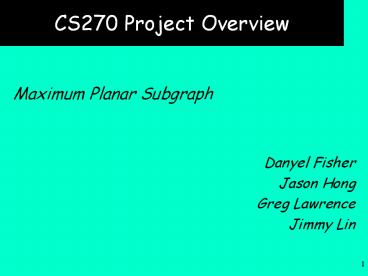CS270 Project Overview PowerPoint PPT Presentation
Title: CS270 Project Overview
1
CS270 Project Overview
- Maximum Planar Subgraph
- Danyel Fisher
- Jason Hong
- Greg Lawrence
- Jimmy Lin
2
Overview
- What is Maximum Planar Subgraph?
- What are the existing approaches?
- What will our approach be?
3
Maximum Planar Subgraph
- Input
- a graph G
- Output
- a subgraph of G of maximum size (edges)
- Why it is useful
- circuit layout
- graph layout
4
Existing Approaches
- Spanning Tree
- Output any spanning tree of graph G
- Performance ratio 1/3 of optimal size
- Maximal Planar Subgraph
- Output any planar subgraph that cannot have any
edges added to it - Performance ratio 1/3 of optimal size
- Some other more complex algorithms
- Performance ratio ? 1/3 of optimal size
- Simpler approximations better than complex?!
5
Newer Approaches
- Triangles Everywhere! Calinescu et al 1998
- Find as many triangles as possible until we have
a spanning subgraph (greedy) - Connect the components together
- Performance ratio 7/18 of optimal size
6
Newer Approaches (cont.)
- Maximize the Cactus! Calinescu et al 1998
- In cactus, cycles are triangles and all edges are
in some cycle - Find Max Triangular Cactus (linear algorithm)
- Connect triangles together
- Performance ratio 4/9 of optimal size
7
The Plan
- Constrained Maximum Planar Subgraph
- Bounded Degree
- Euclidean Graphs (with x,y positions)
- ...
8
The Plan (cont.)
- Approximations close to optimal answer
- Planarity testing
- Linear Time
- Well just find one already implemented
- Approximation Approaches
- Force directed placement
- Gradient Descent / Simulated Annealing
- Randomization
- Planarity Testing
- Non-planarity Testing
9
The Plan (cont.)
- Evaluation of Approximations
- Empirically evaluate
- Generate random and pathological graphs
- Run approximations on graphs
- Compare performance ratio
- Select a promising approach
10
Summary
PowerShow.com is a leading presentation sharing website. It has millions of presentations already uploaded and available with 1,000s more being uploaded by its users every day. Whatever your area of interest, here you’ll be able to find and view presentations you’ll love and possibly download. And, best of all, it is completely free and easy to use.
You might even have a presentation you’d like to share with others. If so, just upload it to PowerShow.com. We’ll convert it to an HTML5 slideshow that includes all the media types you’ve already added: audio, video, music, pictures, animations and transition effects. Then you can share it with your target audience as well as PowerShow.com’s millions of monthly visitors. And, again, it’s all free.
About the Developers
PowerShow.com is brought to you by CrystalGraphics, the award-winning developer and market-leading publisher of rich-media enhancement products for presentations. Our product offerings include millions of PowerPoint templates, diagrams, animated 3D characters and more.

